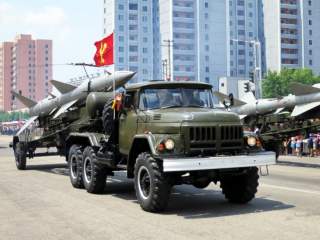America’s Five-Year Flip-Flop on North Korea’s Missiles
North Korea announced that it successfully launched the Kwangmyongsong-4 satellite at 9:30 am on February 7, 2016.
The Democratic People’s Republic of Korea (DPRK or North Korea) announced that it successfully launched the Kwangmyongsong-4 satellite at 9:30 am on February 7, 2016. But the United States regards DPRK satellite launches as thinly-veiled efforts to advance its long-range ballistic missile capabilities. Secretary of State John Kerry condemned the latest launch as “a flagrant violation of UN Security Council Resolutions related to the DPRK use of ballistic missile technology.”
This compilation of statements by U.S. government officials over the past five years shows U.S. assessments regarding North Korea’s ballistic missile capabilities.
January 11, 2011: Then-U.S. Secretary of Defense Robert Gates says during a visit to Beijing that North Korea could have the ability to hit the continental United States with a ballistic missile in five years. [New York Times]
January 27, 2011: Then-Chairman of the U.S. Joint Chiefs of Staff Admiral Michael Mullen says in an interview to the Financial Times: “There’s little doubt in my mind, unless North Korea is deterred, that sometime in the next, I’m not sure but, five to ten years, the provocations. . . will continue at a much higher threat level, which could include a nuclear-capable ICBM.” [Yonhap]
March 11, 2011: Then-U.S. Defense Intelligence Agency Director Lieutenant General Ronald Burgess says: “The North may now have several plutonium-based nuclear warheads that it can deliver by ballistic missiles and aircraft as well as by conventional means.” [Yonhap]
March 18, 2013: Then-Vice Chairman of the U.S. Joint Chiefs of Staff Admiral James Winnefeld says: “We believe the KN-08 probably does have the range to reach the United States.” KN-08 (also known as No-Dong C and Hwasong-13) is a road-mobile intercontinental ballistic missile under development by North Korea. The missile was first displayed during a military parade in April 2012. [Hankyoreh]
April 11, 2013: The U.S. Defense Intelligence Agency (DIA) assesses that North Korea has successfully miniaturized its nuclear warheads to fit on ballistic missiles, although the agency notes that the nuclear missile’s “reliability will be low.” U.S. Director of National Intelligence Lieutenant General (retired) James R. Clapper Jr. releases a statement soon after noting that the DIA assessment did not reflect the U.S. intelligence community’s assessment as a whole and that he believes that “North Korea has not yet demonstrated the full range of capabilities necessary for a nuclear armed missile.” Pentagon Press Secretary George Little says: “It would be inaccurate to suggest that the North Korean regime has fully tested, developed or demonstrated the kinds of nuclear capabilities referenced in the passage.” [New York Times] [New York Times]
April 16, 2013: U.S. President Barack Obama says: “You know, based on our current intelligence assessments, we do not think that they have that capacity [ability to mount a nuclear warhead on a ballistic missile to hit the United States].” [New York Times]
October 24, 2014: U.S. Forces Korea Commander General Curtis M. Scaparrotti says that North Koreans “have the capability to have miniaturized the device [a nuclear warhead] at this point, and they have the technology to potentially actually deliver what they say they have,” but he also says that a nuclear-tipped missile “that complex, without it being tested, the probability of it being effective is pretty darn low.” [New York Times]
April 7, 2015: Head of the U.S. Northern Command Admiral William Gortney says: “Our assessment is that they have the ability to put a nuclear weapon on a KN-08 and shoot it at the homeland.” KN-08, as noted above, is a road-mobile intercontinental missile. [Bloomberg]
May 19, 2015: Admiral James Winnefeld refutes North Korea’s claim of a successful submarine-launched ballistic missile ejection test and says that the North Koreans “have not gotten as far as their clever video editors and spinmeisters would have us believe. . . They are years away from developing this capability.” [Washington Post]
May 20, 2015: North Korea claims that it can miniaturize its nuclear warheads, but U.S. National Security Council spokesman Patrick Ventrell says: “We do not think that they have that capacity.” [CNN]
October 8, 2015: Admiral William Gortney reiterates the assessment during an Atlantic Council event that the North Koreans “have the capability to reach the [U.S.] homeland with a nuclear weapon from a rocket.” [Guardian]
Scott A. Snyder is a senior fellow for Korea Studies and Director of the Program on U.S.-Korea Policy at the Council on Foreign Relations. Compiled by Sungtae “Jacky” Park, research associate for Korea studies. This article first appeared in Asia Unbound.
Image: Flickr/Stefan Krasowski.

